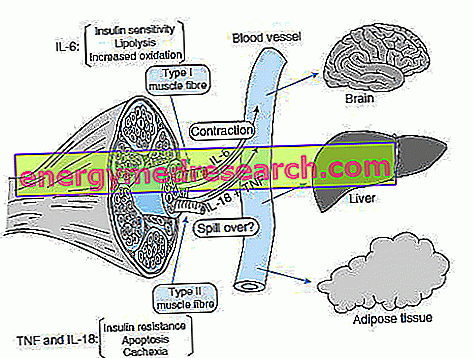By Dr. Cesare Squillace, PhD
It is now widely accepted by the entire scientific community that regular physical exercise determines a physiological protective response to many causes of mortality, and of contrast to inflammatory phenomena such as atherosclerosis and insulin resistance. Performing regular exercise allows the skeletal muscles not only to contract, but also to secrete and pour into the circulatory stream an anti-inflammatory cytokine: IL-6 (interleukin 6). Scientific evidence shows that it stimulates the production and release of other circulating cytokines such as IL-1ra (inteleukin-1 receptor antagonist) and IL-10 (interleukin 10); it also inhibits the production of pro-inflammatory interleukins such as TNF-α (tumor necrosis factor-alpha). IL-6 facilitates lipid turnover, stimulates lipolysis as well as ß-oxidation.
There are numerous studies that underline how regular exercise induces the suppression of TNF-α, offering protection against the insulin resistance generated by the cytokine itself. Recently, IL-6 has been defined as the first " myokine " produced and released by the individual skeletal muscle fibers following their contraction, exerting its effects also on other organs of the body.
We know that skeletal muscle is the largest organ in the human body; the discovery that simple muscle contraction results, not only in a biomechanical response, but also in the production of anti-inflammatory cytokines, opens up new paradigms: skeletal muscle is an endocrine organ that through contraction stimulates the production and release of cytokines, which can influence the metabolism and modify their production in tissues and organs (figure 1).

Fig.1 Skeletal muscle tissue must be considered an important endocrine organ, which expresses and releases cytokines (also called myokines) in the circulatory stream and potentially influences metabolism and inflammatory status in tissues and organs (from Pedersen BK, 2006).
During sepsis conditions and in experimental models, the cytokine cascade includes TNF-α, IL-1β, IL-6, IL-ra, sTNF-R and IL-10. The first two cytokines appear to be TNF-α and IL-1ß, produced locally. These cytokines are classically recognized as pro-inflammatory. These same stimulate the production of IL-6 which has been classified with both pro and anti-inflammatory action. The cytokines produced during exercise differ from those present following infections. The fact that the classic pro-inflammatory cytokines, TNF-α and IL-1ß, in general do not increase with exercise indicates that the exercise-induced cytokine cascade differs from that induced by a common infection.
The first cytokine released in the circulatory stream, during exercise, is IL-6. The circulating levels of the same increase exponentially (100 times more) in response to exercise, and decrease in the post-exercise period (figure 2).

Fig. 2 During a chronic inflammatory state caused by a systemic infection (sx), the cytokine cascade within the first few hours is represented by TNF-α, IL-6, IL-1ra, sTNF-R and IL-10 . Cytokines in response to exercise (dx) do not include TNF-α but show a marked increase in IL-6, which is followed by IL-ra, sTNF-R and IL-10. There is no evidence of increases in C-reactive protein (PCR) levels (from Pedersen BK, 2006).
In summary, we can say that performing regular exercise generates an anti-inflammatory response that is expressed through the production of an important cytokine such as IL-6. It acts on different tissues and at the same time stimulates the production of IL-ra and IL-10, inhibiting the pro-inflammatory cytokine TNF-α. Therefore the skeletal muscle, through the simple muscular contraction, produces and releases "myokines" that mediate the beneficial effects of physical exercise and play a fundamental role, protecting and contrasting a state of chronic inflammation such as that present in cardiovascular diseases and type diabetes 2.
Bibliography
Brandt C, Pedersen BK., 2010, Biomed Biotechnol, The role of exercise-induced myokines in muscle homeostasis and defense against chronic diseases .
Helmark IC, Mikkelsen UR, Børglum J, Rothe A, Petersen MC, Andersen O, Langberg H, Kjaer M., 2010 , Exercise increases interleukin-10 levels both intraarticularly and peri-synovially in patients with knee osteoarthritis: Arandomized controlled trial, Arthritis Res Ther.
Pedersen BK, February M., 2005 , Muscle-derived interleukin-6 - a possible link between skeletal muscle, adipose tissue, liver, and brain, Brain Behav Immun.
Pedersen BK, 2006, Essays Biochem, the anti-inflammatory effect of exercise: its role in diabetes and cardiovascular disease control .
Pedersen BK. 2009 , The diseasome of physical inactivity - and the role of my muscle in muscle - fat cross talk ., J Physiol.
Pedersen BK., 2011, Exercise-induced myokines and their role in chronic diseases .
Brain Behav Immun.



